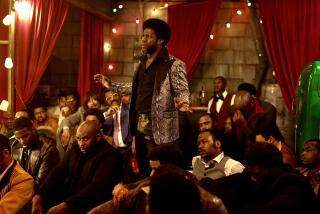Breaking Bones and Barriers
Pasted in a corner of Eddie Smithâs scrapbook is a small, yellowed newspaper clipping from 1969 telling of a helicopter crash on the set of a war movie in which a pilot and two stuntmen âescaped injury.â The movie was âMASHâ; Smith was one of the stuntmen; and as he walks across the den of his Culver City home on this spring day more than 30 years later, he still has a limp from that accident. Although heâs free to grouse about the pain now, back then he held his tongue.
âI couldnât mess it up for the rest of the group, man,â says Smith, 78. âWe fought too hard. We had to show ourselves.â
The group he speaks of is the Black Stuntmenâs Assn., or BSA, which he co-founded in 1967 with African American film extras, horsemen and athletes. They risked their necks in front of the cameras and behind the scenes, fighting to break through the color barrier in the stunt business.
âOur thought was that youâd have to be better than good to get the job,â says the groupâs co-founder, Henry Kingi, 58. âAll they needed was to have one of us mess up so they could say, âSee, they donât know what theyâre doing.â â
Smith brought together several old BSA members at his house last month to talk about their trials and triumphs. A few days later, âThe 2nd Annual World Stunt Awardsâ (which aired May 31 on ABC) would be taped in Santa Monica. There were no awards for any BSA members, and no one here is complaining. Instead of bitter railings against injustices they faced, the bulk of the conversation is devoted to fond memories and former running mates (âWhatever happened to olâ Half-Foot?â). But their nonchalance belies the importance of their struggle--a lost piece of civil rights and Hollywood history.
Actor-director Sidney Poitier, who worked with black stuntmen on âUptown Saturday Nightâ and other films, says the BSA made a contribution âthat is all too often not remembered or recognized by the industry. A lot of the guys, like myself, weâve moved on in years, and some of them have retired by now and some have gone on to other things. But they were quite a force, and they were substantive in their skills and their contributions.â
In the first few decades of the film business, whenever an actor of color needed to be doubled for a dangerous action sequence, a white stuntman would be coated with the appropriate shade of makeup. As the civil rights movement gained momentum in the â60s and blacks and other minorities were featured more prominently in movies and on TV, the practice--known as a âpaint-downâ--became even more glaring. Not only was it insulting, but it also robbed nonwhite performers of a potentially rich source of income, a fact readily apparent to show-business journeyman Smith.
Smith had been kicking around Hollywood since 1955 as a film extra and freelance TV news cameraman covering breaking stories for local stations in areas where most white newsmen feared to tread.
Working on the sets of films and TV shows, he noticed the discrepancy between his earnings as an extra and those of white stuntmen: âA white stunt guy would say, âI had a pretty good week. I guess Iâll go down to Palm Springs.â And Iâd think, âI ainât made enough money to take the Red Car to Watts.â â
The catalyst for the black stuntman group came on the set of the 1963 film âItâs a Mad Mad Mad Mad Worldâ when Smith witnessed a white stuntman being painted to double black actor Eddie âRochesterâ Anderson for the climactic struggle. Smith complained to director Stanley Kramer.
âEddie asked, âWhy isnât a black stuntman doubling Rochester?â â Kingi says, âand Kramer said, âWell, find me one.â And Eddie said, âUh, OK.â â
âMan, I couldnât get no brothers nowhere,â recalls Smith, who officially retired from stunt work in 1996 but still works regularly as a recruiter of African American extras for film and TV projects. âBut I told him, âNext time Iâll be able to supply you with what you want.â â
Recruiting, Then Tutoring Stuntmen
The BSA didnât actually come into existence until 1967, when Smith approached Kingi and other friends who rode in a re-creation of the all-black U.S. 10th Cavalry Unit, known as the Buffalo Soldiers, and asked if theyâd like to be movie stuntmen.
âWe were doing stunts off of horses and fights already,â says Len Glascow, leader of the Los Angeles chapter of the Buffalo Soldiers. âEddie said, âYou guys might as well join.â â Augmented by an assortment of extras and former athletes, the future stuntmen trained strenuously on weekends, riding motorcycles, learning to fall off horses and piloting rental cars through traffic cones. At Athens Park in South L.A., the group practiced fight scenes and high falls off backstops and bleachers onto mattresses.
âWeâd look across the street and thereâd always be cops in unmarked police cars watching,â Kingi says, laughing. âWe figured they thought we were another Black Panther group forming.â
They were helped by Glenn Wilder and Ronnie Rondell, two top young white stuntmen of that era who in 1970 co-founded Stunts Unlimited as a more forward-looking alternative to the older Stuntmenâs Assn.
âRonnie and I spent five or six weekends showing them how to do fights, falls and car hits,â Wilder says. â... A lot of the established stunt people were not too happy with us because of that, but we didnât care.â
No matter how hard BSA members trained, white stunt coordinators who controlled the hiring were still reluctant to give them work.
Matters came to a head on the set of the Warner Bros. western âSkin Gameâ (1971) when a white stuntman was called in to double African American Louis Gossett Jr. Smith found out and argued that there was a black man named Tony Brubaker (later a top stuntman) more than capable of handling it.
The NAACP, the Equal Employment Opportunity Commission and the Screen Actors Guild were soon drawn into the controversy. In May 1971, Warner Bros. agreed not only to hire black stunt people to double black actors but also to include black stuntmen in all scenes involving general stunt work. They also invited members of the black stunt community to train with experienced white stuntmen on the studio lot and at Randall Ranch in Newhall.
Not all of the white stunt establishment was so welcoming, according to Smith and other BSA members. Because of the groupâs activism, members were branded as troublemakers, and the jobs they fought for often went to black stuntmen who didnât make waves.
âThey resented the fact that we were taking money from their pockets,â Kingi says of the white stuntmen. âThey also didnât like taking orders.â
Wilder agrees that the established white stuntmen were angry about losing work to black stuntmen, not to mention white stuntwomen, who at the time were waging their own battle to get the men to stop donning wigs and dresses and to let them double their own gender. Three decades later, the race issue remains hard to unravel. Many of the major players from the âSkin Gameâ era are dead, and the ones still alive are fearful of being considered--justly or unjustly--racists.
The wave of action-oriented blaxploitation films in the early â70s, along with the overall improvement of race relations, created more job opportunities for BSA members. But Smith, who scored a prestigious gig as a stunt coordinator on the 1973 James Bond film âLive and Let Die,â still kept an eye out for injustice.
âWe were members of everything ... PUSH, CORE, the NAACP,â Kingi says. âEddie would call studios and say he was the Black National Congress leader of the African Society of Whatever-It-Was and heâd heard there was a problem, then we would go in as the group and follow up on it. Every time Eddie would tell us, âWeâve got another situation,â weâd say, âOK, who are we today, Eddie?â â
In the ensuing years, BSA members such as Alan Oliney, Alex Brown, Ernie Robinson, Smith and Kingi found consistent work as stuntmen and stunt coordinators. As their personal fortunes improved, the group drifted apart, but they still keep in touch today and, although paint-downs do still occur on occasion, Kingi is proud of how much has changed.
Says Kingi: âWe were either going to do or die. We were not going to sell out or be bought out. No one said, âIâll take this and you get nothing.â Thatâs what was so good about it: We all stuck together.â
More to Read
Only good movies
Get the Indie Focus newsletter, Mark Olsen's weekly guide to the world of cinema.
You may occasionally receive promotional content from the Los Angeles Times.










